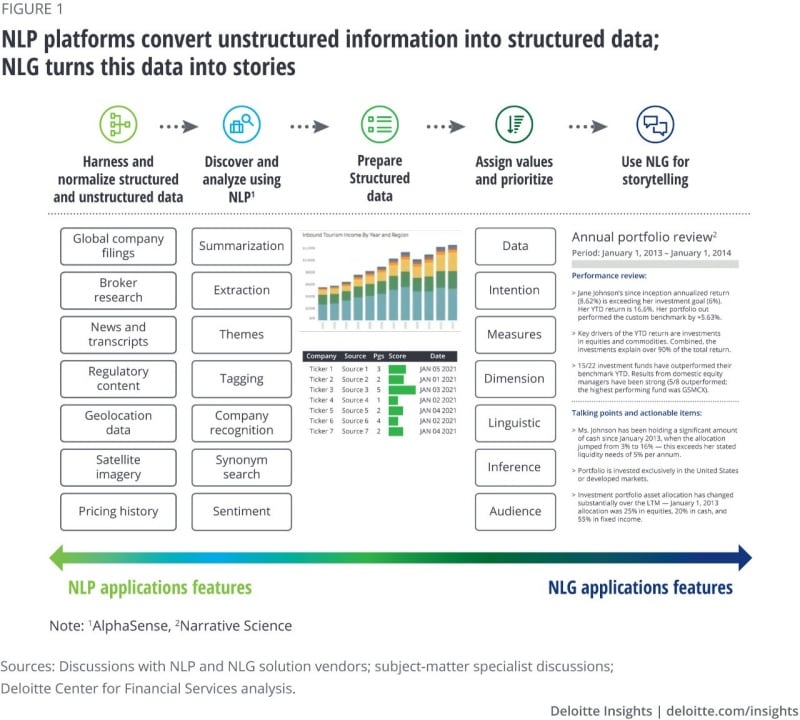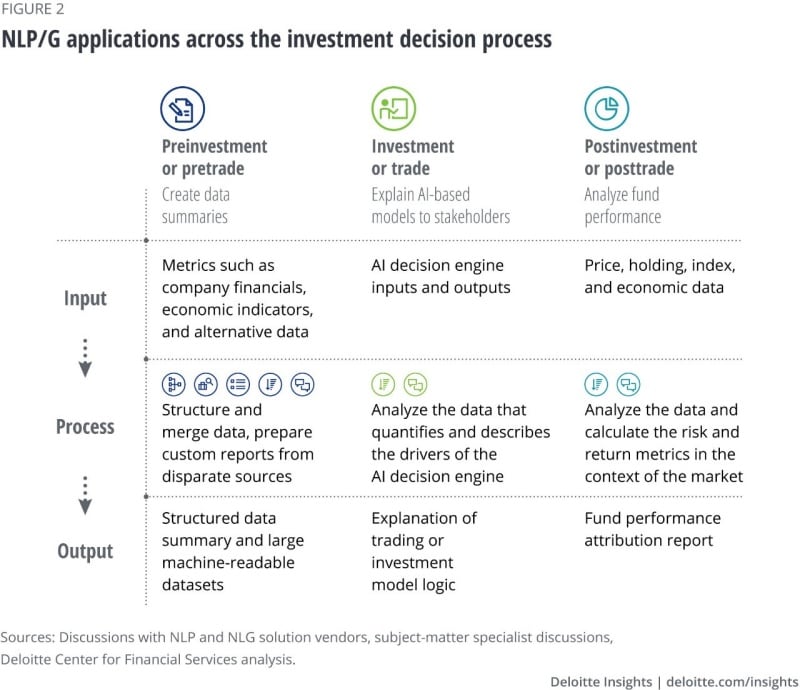Positioning to adopt NLP and NLG platforms
To convert the possible benefits of NLP/G adoption into reality, investment managers may benefit from reexamining their strategic vision and talent approach. There is a long adoption curve ahead, and firms may help drive initial adoption by balancing short- and long-term objectives. Leading practices suggest that implementation and execution are best supported with a refresh of talent strategies, including positioning technology as an enabler rather than a threat.
Senior leadership buy-in is often key for adoption. Both the chief investment officer and portfolio managers should be onboard to help with challenges and integrate the technology and investment teams. Once the objectives of NLP/G adoption are truly shared, an organization can pursue them in a coordinated fashion.11 Close collaboration between technology, investment, data science, and strategy teams can help drive NLP and NLG adoption.
Four areas in talent management will likely contribute to long-term NLP/G success:
Recruitment and training. Appoint experienced data science professionals in key roles. Early AI leaders have made it a point to recruit people with skills such as mathematics and advanced physics.12 Train new analysts in coding and AI applications.
Organizing in teams. Start with small teams, focusing on using AI to automate routine, repetitive tasks. Have a mix of capabilities within teams to drive innovation. Work toward creating “superteams” that have a mix of analyst, technology, and investment strategist skill sets.13
Performance management. Realign incentives from span of analyst control to innovation using technology. Manage redeployment of investment professionals based on skill sets and experience. Align processes and performance management to adjust for AI’s inclusion on the team.
Culture. Shift the mindset to technology as a business partner for the investment team, not as a service. Inculcate a culture of regular training and upskilling for all members of the investment team.
A leading investment firm followed many of these principles in their path to NLP/G adoption. Leaders within the firm sprinkled data scientists across the investment groups, added coding and analytics to the requirements for new junior-level portfolio managers and analysts, and offered existing investment staffers training in those skills, to free up the investment team’s time. For hiring, the firm began approaching not only schools’ finance majors but physics departments and other areas where someone might have expertise in coding and analytics. The firm also created training camps for anyone else who’s interested. In all, the firm has trained 75 investment staffers—analysts, portfolio managers, and traders—on coding and analytics.14 Talent and technology strategy go hand in hand; to be successful over the longer term, talent develops the organizational capability to drive the strategy.
Path forward for investment managers
Investment managers are at a juncture where the adoption of NLP/G platforms today may create a competitive advantage for years to come. In a recent Deloitte survey, 86% of financial services adopters predicted that AI will be very or critically important to their business success in the next two years, in line with investment management respondents.15 NLP/G platforms could be good candidates for a place to start, with more than half of investment management firms surveyed planning to implement these technologies in 2021.16
NLP and NLG support the three phases of the investment decision process in very different ways, and the decisions to deploy this technology in any of the phases are independent. Firms using NLP/G may identify investment opportunities sooner and improve operational efficiency. The time saved by analysts gathering data in the pretrade stage can be used to broaden the coverage universe or conduct a deeper analysis of already-covered companies. These improvements may enable analysts to identify the strongest investment ideas and potentially increase alpha. In the investment phase, the NLG engines can help firms communicate the rationale behind AI-supported decisions rather than treating them as black boxes. This capability can help firms continuously improve the existing decision-making algorithms and develop new ones. Finally, in the posttrade phase, NLP/G engines can generate portfolio commentaries from performance data on demand in seconds, instead of requiring days of manual effort each time.
The technology’s greatest benefit comes from being able to process large amounts of data quickly. There are no difficult prerequisites for implementation of NLP/G in the pre- and post-trade phases of the investment process. Many firms will likely start their AI journey with NLP/G technologies in these phases. For the investment decision point, NLP/G is likely best used to explain an AI decision engine’s output. This implementation often comes in conjunction with developing an AI decision support capability.
As investment management firms set out to digitally transform their operations, leaders will likely increasingly look to AI technologies. It should be encouraging that NLP/G has the potential to play a key role in reimagining the heart of active management—the investment decision process.














